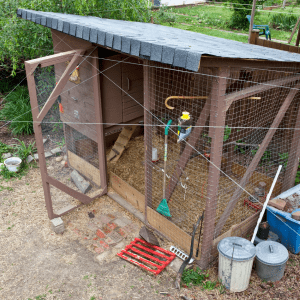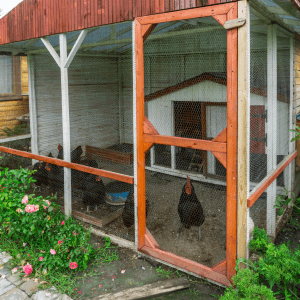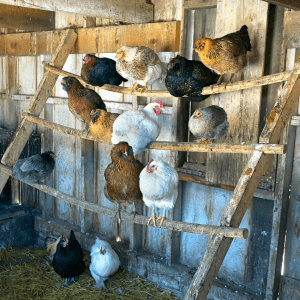Building Your Own Chicken Coop
Introduction to Building Your Own Chicken Coop
Embarking on the journey of building your own chicken coop is an exciting endeavor for any poultry enthusiast. This comprehensive guide aims to provide you with all the necessary information to create a safe, comfortable, and functional home for your chickens. From selecting the right materials to ensuring proper ventilation, every aspect of coop building is covered to help you build a coop that not only meets the basic needs of your chickens but also enhances their overall well-being.
Planning Your Chicken Coop
Determining the Size
The size of your chicken coop is crucial. As a general rule, each chicken requires about 2-3 square feet inside the coop and 8-10 square feet in the run. However, bigger is often better to avoid overcrowding, reduce stress, and prevent disease.
Choosing the Right Location
The location of your coop can significantly impact the health and happiness of your chickens. Choose a spot that provides good drainage, protection from extreme weather, and easy access for cleaning and egg collection.

Building a Chicken Coop – Design Considerations
Ventilation is Key
Adequate ventilation is a critical aspect of chicken coop design, essential for maintaining the health and comfort of your flock. Proper air circulation prevents the buildup of ammonia and moisture, which are harmful to chickens. It’s important to strike a balance – too much ventilation can create drafts, while too little can lead to dampness and respiratory issues.
To ensure effective ventilation, incorporate several adjustable vents or windows that can be opened or closed depending on the weather. The placement of these vents is crucial; they should be located high in the coop to allow warm, moist air to escape and placed opposite each other to promote cross-ventilation. However, they must be designed in such a way to prevent direct drafts on the birds, especially during colder months.
Consider using vent covers that can be adjusted or removed as needed. In colder climates, insulating these vents can help maintain a comfortable temperature inside the coop while still allowing air flow.
Lighting and Insulation
Chickens need a certain amount of light each day for optimal health and egg production. Natural light is ideal, so positioning windows to capture sunlight is beneficial. If natural light is insufficient, especially during shorter winter days, supplemental lighting can be used. Ensure that any electrical installations are safe and protected against pecking or damage.
Insulation plays a crucial role in maintaining a stable internal temperature. In areas with cold winters, proper insulation helps keep the coop warm. On the other hand, in hot climates, insulation can help keep the coop cooler. The key is to balance insulation with ventilation to avoid moisture buildup. Materials like rigid foam panels can be effective for insulation while still being lightweight and easy to install.
Coop Layout and Space Utilization
Efficient use of space is vital, especially in smaller coops. Consider the daily activities of your chickens and design the interior layout to accommodate these behaviors. Provide enough space for feeding, drinking, roosting, and laying eggs without overcrowding.
Design the coop with ease of cleaning in mind. Removable trays under roosting bars, easily accessible nesting boxes, and doors or panels that open for cleaning can make maintenance simpler and more efficient.
Safety and Security
Safety for your chickens means keeping them protected from predators and environmental hazards. The coop should be built with sturdy materials that can withstand attempts by predators to break in. All openings, including doors, windows, and vents, should be covered with predator-proof hardware cloth, not just chicken wire which is less durable.
Consider a secure locking system for doors to prevent predators from gaining access. Raccoon-proof latches are a good investment as raccoons can open simple latches.
Flooring and Bedding
The choice of flooring in a chicken coop is important for both the health of the chickens and ease of cleaning. Concrete floors are easy to clean and rodent-proof but can be cold and hard on chickens’ feet. Wooden floors are warmer but require more maintenance and are prone to rot. Whatever flooring you choose, it should be covered with a suitable bedding material like straw, mulch or other soft material.

Selecting Materials for Durability and Safety
When building a chicken coop, choosing the right materials is crucial for ensuring both the durability of the structure and the safety of your chickens. The materials you select must withstand various weather conditions, deter predators, and maintain a healthy environment for the chickens.
Wood for Structure:
The most commonly used material for chicken coops is wood due to its availability, ease of use, and natural insulation properties. However, it’s important to choose the right type of wood. Cedar and redwood are excellent choices due to their natural resistance to rot and pests. If budget constraints lead you to choose more affordable woods like pine, consider treating them with a non-toxic sealant to extend their durability.
Hardware Cloth for Security:
For windows and outdoor runs, hardware cloth is preferable over chicken wire. Hardware cloth, made of a sturdier gauge wire, is more effective in keeping predators like raccoons and foxes out. Ensure that the mesh size is small enough (usually 1/2 inch) to prevent predators from reaching in.
Roofing Materials:
The roof should be waterproof and sturdy. Metal roofing is a popular choice as it’s durable, rodent-proof, and provides excellent protection from the elements. Alternatively, asphalt shingles can also be used, offering good weather resistance and a more traditional aesthetic.
Flooring Options:
The coop floor should be easy to clean and resistant to moisture. Concrete flooring is ideal for its ease of cleaning and pest resistance. However, it can be cold in winter, so adding a layer of straw or wood shavings can provide additional warmth. For a more natural option, a wooden floor raised above the ground level can promote air circulation and prevent dampness.
Ventilation Systems:
Use materials that allow for proper ventilation without letting in drafts. Sliding windows or vents can be built with a combination of wood and hardware cloth. They should be positioned strategically to ensure cross-ventilation while protecting the chickens from direct drafts.
Insulation Materials:
In colder climates, insulation is important. Foam board or fiberglass insulation can be used between the wall layers. However, ensure that these materials are covered so the chickens cannot peck at them.

Paints and Finishes:
Use only non-toxic paints and finishes inside and outside the coop. Chickens tend to peck at surfaces, and using non-toxic materials is crucial to prevent them from ingesting harmful substances.
Predator Deterrents:
In addition to hardware cloth, consider additional deterrents like secure locking mechanisms for doors and windows. Simple slide bolts may not be enough; raccoons, for instance, can open some locks.
Selecting the right materials is a balance between cost, durability, and the health and safety of your chickens. Investing in quality materials upfront can save money and time in the long run by minimizing repairs and ensuring the wellbeing of your flock.
Inside the Coop: Nesting Boxes and Roosting Bars
Creating a comfortable and functional interior is crucial for the health and productivity of your chickens. Two essential components of the coop’s interior are the nesting boxes and roosting bars.
Nesting Boxes:
Design and Placement:
Each coop should have one nesting box for every three to four hens. The boxes should be placed in the quieter and darker parts of the coop to provide a sense of security and encourage egg-laying. The ideal size for a nesting box is about 12 inches by 12 inches, which provides ample space for the hens without being so large that they feel insecure.
Materials:
Use sturdy, easy-to-clean materials like wood. The inside can be lined with straw or wood shavings for comfort and to make egg collection easier. It’s important to ensure the materials inside the box are soft to prevent egg breakage and provide comfort for the hens.
Accessibility:
Position the boxes at a height that is easy for the chickens to access but off the ground to prevent issues with pests and dampness.

Roosting Bars:
Height and Spacing:
Roosting bars should be placed higher than the nesting boxes to encourage chickens to sleep there, as they prefer to roost at the highest point available.
Ensure there is enough space between bars to prevent overcrowding and to allow for the pecking order.
Design:
The bars should be wide enough for the chickens to comfortably perch, with a flat surface for their feet.
A size of about 2 inches wide is usually ideal. Rounded edges are also important to prevent foot injuries.
Material:
Hardwood is a good choice for durability and ease of cleaning. Avoid materials that are too smooth, as they can cause the chickens to slip.
The Coop’s Exterior: Run Area and Fencing
The exterior of the chicken coop, particularly the run area and fencing, plays a vital role in the health and safety of your chickens. It’s not only about giving them space to roam but also about protecting them from predators and harsh elements.
Run Area:
Space Requirements:
Each chicken should have at least 8-10 square feet of run space. This area should be an extension of the coop, allowing the chickens to move freely between the two. Adequate space is crucial for the chickens’ physical health and to reduce stress and pecking behaviors.
Ground Surface:
The run can have a natural ground surface, which allows chickens to forage and exhibit natural behaviors. However, consider adding a layer of sand or pea gravel for easier maintenance and cleanliness. It also helps with drainage during rainy seasons.
I have always kept a separate pen in case a chicken gets sick as it needs to be immediately separated from the flock till it is better.
Fencing:
Materials: Use sturdy materials for fencing, such as hardware cloth or chain-link fencing, to prevent predators from entering. The fencing should be buried at least 12 inches underground to deter digging predators.
Height and Cover: The fence should be high enough to prevent chickens from flying over – usually, 6 feet is adequate. Consider covering the top with netting or wire to protect against aerial predators like hawks and owls.
Gate Security: Ensure that the entry gate is secure with a good latch system. Raccoons and other intelligent animals can open simple latches, so a more complex locking mechanism may be necessary.
Shelter and Shade:
Provide sheltered areas within the run for protection against sun, rain, and wind. This can be achieved with a simple roofed structure or by planting shrubs and trees for natural cover.
Enrichment:
To keep your chickens engaged and active, add features like perches, dust bathing areas, and safe edible plants within the run. This not only enriches their environment but also contributes to their overall well-being.
The design of the run area and fencing is essential for providing a safe, stimulating, and comfortable outdoor space for your chickens. It encourages natural behaviors, provides protection from predators, and ensures a happy and healthy flock.
Building Your Own Chicken Coop – Maintenance and Upkeep
Easy-to-Clean Features
Incorporate features that make the coop easy to clean, such as removable trays, large doors, and materials that withstand frequent washing.
Regular Maintenance Tips
Routine inspections for pests, wear and tear, and cleanliness are essential for a well-maintained coop.
Addressing Common Coop Building Challenges
Weather Considerations
Design your coop to withstand local climate conditions, whether it’s heat, cold, or humidity.
Budgeting and Cost-Saving Tips
Careful planning can help keep costs down. Reuse materials when possible, and buy in bulk to save money.

Building Your Own Chicken Coop vs. Pre-built Coops
Pros and Cons of DIY Coops
Building a coop yourself can be more affordable and allows for customization. However, it requires time, skills, and effort.
Assessing Pre-built Options
Pre-built coops offer convenience and professional design but may be more costly and less customizable.
Conclusion: Building Your Own Chicken Coop
A well-designed chicken coop is the cornerstone of a happy and productive flock. By considering each aspect of coop construction, from space and security to comfort and maintenance, you can create an ideal home for your chickens that meets their needs and simplifies your poultry-keeping experience.
Remember, the perfect chicken coop doesn’t just house your chickens; it supports their health, safety, and natural instincts. With this comprehensive guide, you are well-equipped to build a coop that will serve as a comfortable and secure haven for your feathered friends for years to come.
Other Articles You May Find Interesting
Rosemary a Pest Repellent of Grandeur
Benefits of Marigolds in your Coop Environment
Araucana Chickens Care – Tips and Tricks
Rose petals in the Chicken Coop
10 Effective Ways to Keep Snakes Out of your Chicken Coop
Beginner Chicken Care Mistakes






